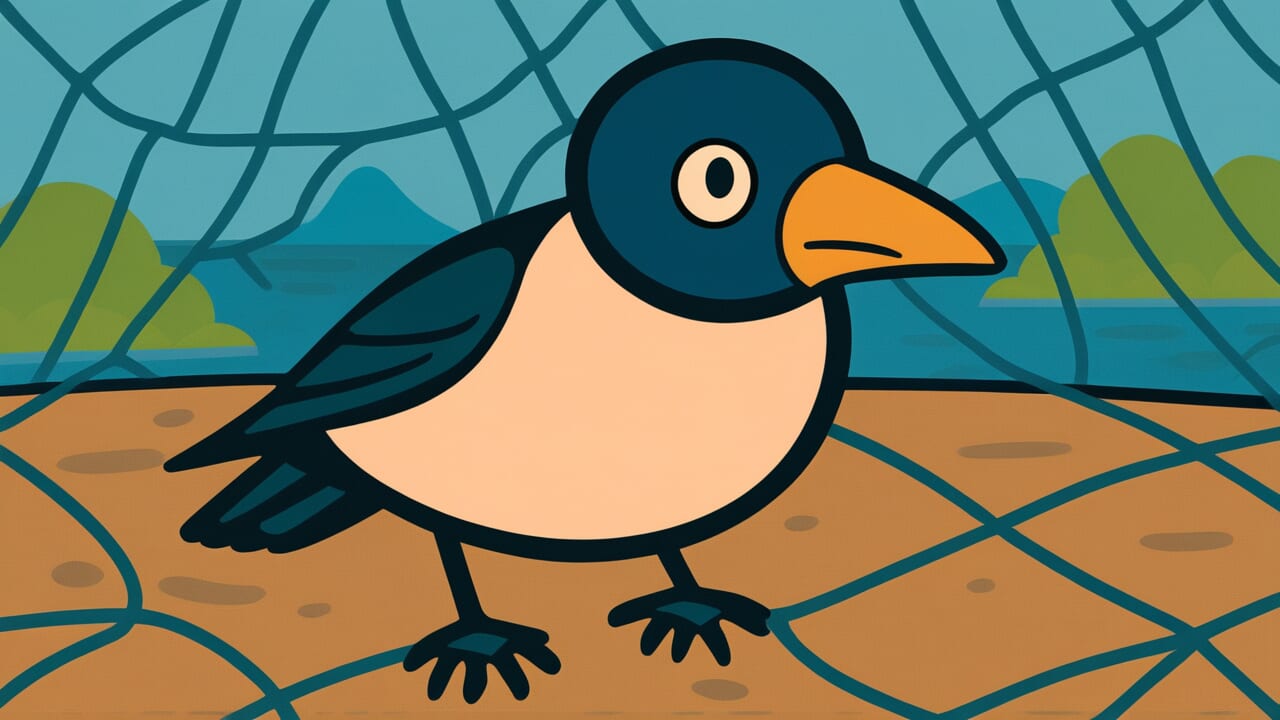How to Read “You cannot catch a bird with a net of one mesh”
Ichimoku no ami wa motte tori wo ubekarazu
Meaning of “You cannot catch a bird with a net of one mesh”
This proverb means that you cannot achieve great results with just one method or approach.
When you try to reach a goal, relying on only one way or one tool makes it hard to get the results you want.
Just as a net with only one mesh cannot catch a bird, you need to combine multiple elements and approach things from different angles to succeed.
People use this proverb when someone is stuck on a single method. It encourages them to broaden their perspective.
It also applies when making plans. The saying reminds us to prepare multiple options and complementary strategies, not just one approach.
This wisdom still applies today in business, learning, and relationships. Develop multiple skills, not just one.
Create multiple income sources, not just one. Successful people always use multi-faceted approaches.
Origin and Etymology
This proverb likely comes from ancient Chinese classics. It uses the image of catching birds with a net as an example.
The key lies in the word “one mesh.”
A net only works when countless meshes combine together. With just one mesh, a bird easily slips through the gap.
No matter how strong the thread, a single mesh alone serves no purpose. The entire net must work together to catch a bird.
This expression probably came from practical wisdom in ancient China. Hunting and fishing were vital activities directly connected to people’s survival.
The lessons learned from experience eventually evolved into life wisdom.
The proverb came to Japan through Chinese texts. Similar expressions appear in educational books from the Edo period.
Using an everyday tool like a net, it conveys a deep truth. Achieving big goals requires multiple elements and efforts.
The teaching emphasizes multi-faceted approaches rather than relying on one method. This wisdom has been passed down through generations.
Usage Examples
- To get new customers in sales, you cannot catch a bird with a net of one mesh. You need to use email and social media, not just phone calls.
- For exam prep, you cannot catch a bird with a net of one mesh. You can’t rely on just one textbook. You need past exams and practice tests too.
Universal Wisdom
Humans have a tendency to stick to one method. We want to believe in familiar ways, our strengths, and the tools right in front of us.
We think they should be enough. Why? Because thinking about and executing multiple methods takes enormous energy.
But our ancestors understood something important. The world is complex, and one thread alone catches nothing.
Just as a net consists of countless meshes, success in life comes only through countless small efforts, diverse methods, and layers of preparation.
This proverb has endured because humans have always fought this temptation. We want to take it easy, get results efficiently, and solve everything with one method.
This desire exists strongly in human hearts, no matter the era.
That’s why this teaching has universal value. If you want to catch something big, you need the resolve to weave an entire net, not just one mesh.
It means diversity in effort, layers in preparation, and an open attitude toward possibilities.
This proverb still shines today because it knows human weakness and shows wisdom to overcome it.
When AI Hears This
The phenomenon where one mesh cannot catch a bird is exactly what network science calls the “critical density” problem.
Consider the internet as an example. If only 10 computers existed worldwide and only 2 were connected, it would be almost meaningless.
But when connections exceed a certain ratio, the entire network suddenly begins to function. This is called a “phase transition.”
What’s interesting is that this turning point can be predicted mathematically. According to random network theory, when the number of nodes is N, a giant connected component emerges when average connections exceed 1.
In other words, as meshes increase to 2, 3, and more, at some point it suddenly transforms into “a net that can catch birds.”
This follows the same principle as water turning to ice at 0 degrees Celsius.
Brain synaptic connections work the same way. Individual neurons existing separately cannot produce consciousness.
But when connection density exceeds a critical point, complex thinking suddenly becomes possible.
This proverb recognized long before scientific language existed that function requires a “transition point from quantity to quality.”
One mesh is powerless, but when multiple meshes cooperate, the entire system gains abilities of a different dimension. This is the essence of networks.
Lessons for Today
This proverb teaches modern people the importance of having “insurance” in life. This isn’t just caution.
It’s an active strategy to maximize possibilities.
When thinking about your career, don’t polish just one skill. Develop multiple related abilities.
Your value will multiply many times over. In relationships too, don’t depend on just one person.
Having diverse connections makes life richer and more stable.
When pursuing goals, prepare not just Plan A, but also Plan B and Plan C. This isn’t weakness.
It’s true strength. People who can walk another path when one closes are the ones who ultimately reach their destination.
Modern times change rapidly. Clinging to one method or one answer will leave you overwhelmed by the waves of change.
But if you have multiple options and prepare to respond flexibly, you need not fear any change.
Like carefully weaving each mesh of a net, gradually expand your possibilities one by one.



Comments